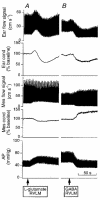Regional blood flow and nociceptive stimuli in rabbits: patterning by medullary raphe, not ventrolateral medulla
- PMID: 10747198
- PMCID: PMC2269856
- DOI: 10.1111/j.1469-7793.2000.t01-2-00279.x
Regional blood flow and nociceptive stimuli in rabbits: patterning by medullary raphe, not ventrolateral medulla
Abstract
1. Regional blood flow was measured with Doppler ultrasonic probes in anaesthetized rabbits. We used focal microinjections of pharmacological agents to investigate medullary pathways mediating ear pinna vasoconstriction elicited by electrical stimulation of the spinal tract of the trigeminal nerve or by pinching the lip, and pathways mediating mesenteric vasoconstriction elicited by electrical stimulation of the afferent abdominal vagus nerve. 2. Bilateral injection of kynurenate into the rostral ventrolateral medulla reduced arterial pressure and prevented the mesenteric vasoconstriction and the rise in arterial pressure elicited by abdominal vagal stimulation. However, kynurenate did not prevent ear pinna vasoconstriction or the fall in pressure elicited by trigeminal tract stimulation. Similar injections of muscimol also failed to prevent the trigeminally elicited cardiovascular changes. 3. Injections of kynurenate into the raphe-parapyramidal area did not diminish trigeminally elicited ear vasoconstriction or the depressor response. However, injections of muscimol substantially reduced or abolished the trigeminally elicited ear vasoconstriction, without affecting the depressor response. Raphe-parapyramidal muscimol injections also entirely abolished ear vasoconstriction elicited by pinching the rabbit's lip. 4. The trigeminal depressor response does not depend on either the rostral ventrolateral medulla or the raphe-parapyramidal region. 5. Mesenteric vasoconstriction elicited by stimulation of the afferent abdominal vagus nerve is mediated via the rostral ventrolateral medulla, but ear vasoconstriction elicited by lip pinch or by stimulation of the trigeminal tract is mediated by the raphe-parapyramidal region. Our study is the first to suggest a brainstem pathway mediating cutaneous vasoconstriction elicited by nociceptive stimulation.
Figures







References
-
- Basbaum AI, Clanton CH, Fields HL. Three bulbospinal pathways from the rostral medulla of the cat: an autoradiographic study of pain modulating systems. Journal of Comparative Neurology. 1978;178:209–224. - PubMed
-
- Blessing WW. Distribution of glutamate decarboxylase-containing neurons in rabbit medulla oblongata with attention to intramedullary and spinal projections. Neuroscience. 1990;37:171–185. - PubMed
-
- Blessing WW. The Lower Brainstem and Bodily Homeostasis. New York: Oxford University Press; 1997.
-
- Blessing WW, Yu YH, Nalivaiko E. Raphe pallidus and parapyramidal neurons regulate ear pinna vascular conductance in the rabbit. Neuroscience Letters. 1999;270:33–36. - PubMed
-
- Bowker RM, Abbott LC, Dilts RP. Peptidergic neurons in the nucleus raphe magnus and the nucleus gigantocellularis: their distributions, interrelationships, and projections to the spinal cord. Progress in Brain Research. 1988;77:95–127. - PubMed
Publication types
MeSH terms
Substances
LinkOut - more resources
Full Text Sources
Medical

